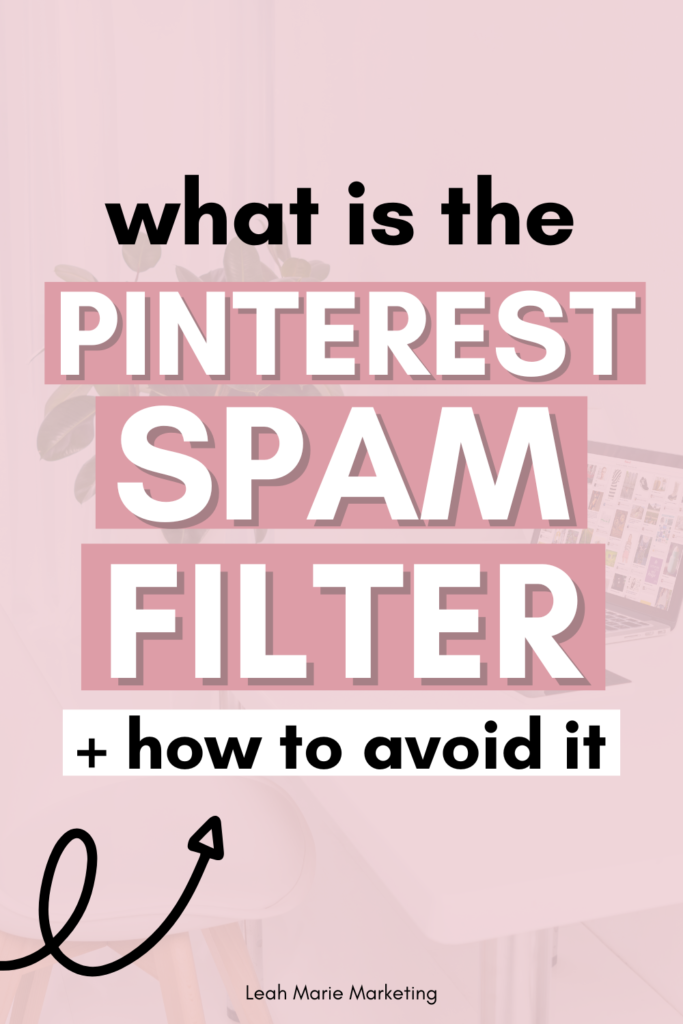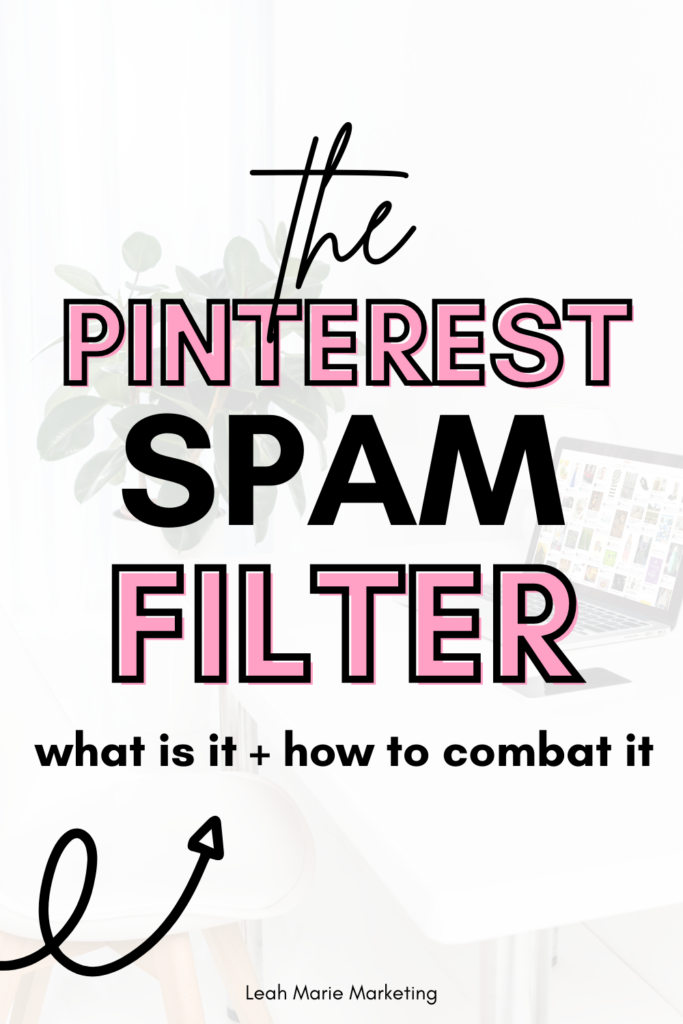
- My experience with the Pinterest spam filter
- What is the Pinterest spam filter
- Spam block vs. website block vs. account suspension vs. rate limit block
- Will Pinterest tell you that you’re in the spam filter?
- Signs your account is in the Pinterest spam filter
- How long does the Pinterest spam filter last?
- Reasons you might be caught in the Pinterest spam filter (and how to prevent it)
- What to do if you’re caught in the Pinterest spam filter
- Are there long-term effects of the Pinterest spam filter?
- Conclusion
I still remember logging into my Pinterest account on February 13 in 2022 to find my Pinterest stats abnormally low. Little did I know, this was the beginning of my long battle with the Pinterest spam filter.
When the spam filter hits your account, it’s devastating. All the work you’ve done feels like it’s gone. You feel like you’re at the beginning again, or worse, because you are just stuck. Stuck until Pinterest feels like suddenly unflagging your account, which can take quite some time.
Here is my story with the Pinterest spam filter and what I did to combat it.
Let’s dive in.
Please note: Pinterest is always changing, and while I try my best to update my posts, not all information may be up to date. If you’re looking too see the most updated tips, strategies, and information, check out this resource page.
My experience with the Pinterest spam filter
In mid February, my Pinterest account was caught in the Pinterest spam filter.
It very quickly ruined my account.
My traffic flatlined, my stats plummeted, my rankings disappeared, and my account was essentially useless.
And after being in the Pinterest spam filter, I have reinvented my Pinterest strategy and have been insanely careful to follow Pinterest’s best practices and updated strategies to avoid it.
Throughout this post, I will be sharing with you everything that I know about the Pinterest spam filter, and I will also be sharing with you what happened to me and what I did to fix it as well as some great resources for learning more.
What is the Pinterest spam filter
First of all, what is the Pinterest spam filter?
The Pinterest spam filter is essentially a block placed on your Pinterest account when Pinterest believes that you have done something categorized as spam. However, as you’ll read later, the spam filter can also be randomly triggered for no reason, meaning that some innocent accounts get mistakenly flagged.
When a Pinterest account is in the spam filter, Pinterest basically hides your content from others. It’s like a shadowban.
It’s like all of a sudden Pinterest just stops showing your content, and this can lead to a huge and sudden decrease in your Pinterest analytics.
In my experience, my impressions dropped to about 5 per hour when it had previously been dozens.
In most cases, your pins are no longer shown and your rankings disappear.
In my personal case, I did see one of my Idea Pins still in search. Other than that, my pins had vanished.
Spam block vs. website block vs. account suspension vs. rate limit block
Before you start to diagnose your own account, it’s important to note that there is a difference between the spam block, website block, account suspension, and rate limit block.
Here’s what each entails:
- Spam filter/block – This is essentially a shadowban on your Pinterest account. Pinterest seems to stop showing your pins to others in the home feed and search results, often causing a sudden and significant decrease in Pinterest stats.
- Website spam block – This is when Pinterest either blocks your site or a URL on your site as spam. When users click on your pins, they will not be able to access your site and will instead see a message that it has been marked as spam. To check for this, try clicking through your pins on a different account to look for this message.
- Account suspension – This is when Pinterest suspends your account and you can’t access it. Pinterest will tell you if this happens usually via email. If this happens to you, you can appeal the suspension through the Pinterest Help Center.
- Rate limit block – This is when Pinterest places a temporary block on your account if Pinterest notices you’ve done a repeated action many times within a short time period. This could include logging in multiple times, commenting, following, and more. Learn more here.
Will Pinterest tell you that you’re in the spam filter?
Unfortunately, no.
(Well, at least very rarely. It’s incredibly difficult to get Pinterest to admit that you’re in the spam filter when you send in a support ticket.)
And that’s one of the frustrating things about it — you never know that you’re officially in the spam block. It’s sort of just a guessing game.
Even if you aren’t certain about being flagged, it doesn’t hurt to reach out to Pinterest support and ask. I’ll talk more about this later.
However, there are definitely prominent signs that you’ll likely see if you have been flagged.
Signs your account is in the Pinterest spam filter
Here are some of the tell-tale signs that your Pinterest account is caught in the spam filter:
- You decreased a very sudden and steep drop in your Pinterest analytics. This can sometimes be in the course of a day of two! If you have a website, you’ll also likely notice a steep decline in website traffic coming from Pinterest as well.
If you have a new Pinterest account and get caught in the spam filter early on, you may just notice incredibly low stats that don’t seem to grow at all. This could be the spam filter, but it could also be due to an outdated or ineffective Pinterest strategy.
- Your pins have disappeared from search. All of your ranking pins will likely be gone. (Unless it is like my case where I could still see one of my Idea Pins.) Try searching the exact title of your pin or your business name and see if anything appears.
How long does the Pinterest spam filter last?
To be honest, I’m really not sure. There is a lot of mystery still surrounding the Pinterest spam filter, especially because Pinterest doesn’t really like to acknowledge it.
Some users have reported that their account randomly seemed to get un-flagged after a few weeks or months of waiting.
One Pinterest marketer, Kayla from Writing From Nowhere, who is an expert in the Pinterest spam filter says that Pinterest needs to mark your account as safe in order for it to go away.
Reasons you might be caught in the Pinterest spam filter (and how to prevent it)
Now you may be wondering, how do you even get in the Pinterest spam filter? Well, unfortunately there are a lot of things it could be.
However, some of the most common reasons are:
- You are following outdated pinning strategies
Two of the biggest outdated pinning strategies that seem to trigger the spam filter are (1) repinning pins or images and (2) pinning the same URL too often.
I think the reason my account got caught in the Pinterest spam filter is because I mistakenly published some pins with the exact same pin images that were already on Pinterest. I also repinned a few of my pins thinking that it wouldn’t be harmful and could only help, but I was in the spam filter shortly after. Of course, there is no way to verify this, but it’s just my hunch. All I know is I won’t do it again!
I do not think there is any circumstance where you should repin pins. Pinterest wants you to share fresh pins – which means a completely new pin image, description, title, etc. You don’t want to risk it.
You also want to make sure you space out when you pin the same URL. I highly suggest waiting at least 24 hours before pinning the same URL, but I often wait 3-4 days minimum just to be extra careful, and I suggest you do the same.
If you have a new Pinterest account, you want to be especially careful. The spam filter is more sensitive to new Pinterest accounts than older ones.
Note: It is also important not to make pins that link to your homepage. This can be seen as repetitive pinning of URLs.
- You are in another country or working with a client in another country
In the middle of August 2022, I absolutely freaked out because I thought my Pinterest account was (yet again) in the spam filter.
Here’s what happened:
I was on vacation with my family in another country (very important, because I am usually located in the US) and logged onto my Pinterest account there to check my account and publish some pins.
While I was there, I did a Pinterest search for a keyword that I usually had a lot of pins ranking for, and all of my pins were gone.
I did more searches for other keywords. I probably had hundreds of ranking pins by this point. And for every single keyword that they normally rank for, not one of my pins appeared. (Except, you guessed it – Idea Pins.)
I was so certain I was in the spam filter. And this sent me spiraling. I sat and thought about it for a while. I didn’t know what I could have possibly done to trigger the spam filter. But then it hit me – could it have something to do with me being in a different country?
I hopped on Facebook and went to a Pinterest group with loads of experts and explained my situation. And that’s when it was confirmed.
A kind member of the group explained that if you are in another country, Pinterest may view this as suspicious activity and may place a temporary suspicious activity filter on your account. Thankfully, she reassured me that this filter often goes away in a few weeks or months.
Now, you may be wondering, what if you travel abroad? Do you just let your Pinterest account suffer? Is there anything you can do? Thankfully, you can prevent this.
The member also explained to me that this is why most Pinterest VAs who have clients in other countries use a VPN. What I believe this does is allow you to change your IP address to another country’s. So essentially, I believe I could have used a VPN and set my IP address to the United States so even when I was in another country, Pinterest would think I was still in the United States and wouldn’t see this as suspicious activity.
Amy LeBlanc, a knowledgeable Pinterest VA, has a great post (read here) on exactly how to use a VPN for Pinterest and her top recommendation. I highly recommend checking it out if you think this may be something you’ll need.
I know for sure if I travel into another country again, I will absolutely be using a VPN.
And, great news — my rankings have already started returning a few days later! So although this didn’t have a long and drawn out impact on my account, I wouldn’t want to take that risk in the future.
- Avoid spikes in activity
Sudden spikes in activity such as commenting, following, and more can be seen as spam-like behavior. Always try to be careful about doing too much in a short window of time.
- You are using URL shorteners
Pinterest does not want you using URL shorteners (like bit.ly) on your pins. These are often seen as spam. Pinterest even mentions this in the Spam section of their Pinterest Community Guidelines. Don’t include these as your destination URL or in the pin description.
- It was a mistake
Unfortunately, “innocent” Pinterest accounts can get caught in the spam filter. If you happen to get caught in it and have no idea what you could have possibly done, unfortunately, this may have happened to you.
Other resources
Here are some other great resources if you want to learn more about the Pinterest spam filter, what causes it, and how to diagnose it:
- How To Spot And Recover From The Pinterest Spam Block
- Pinterest Shadow Ban: What is It and How to Avoid It
- Account Suspended? Avoiding the Pinterest Spam Blocker + Recovering/Reactivating Your Account
What to do if you’re caught in the Pinterest spam filter
Do you think you’re caught in the Pinterest spam filter? Here are some of the steps you can take:
- Send a support ticket to Pinterest
If you have any inkling that you’re in the Pinterest spam filter, you should send a support ticket to Pinterest. It never hurts! You can send a support ticket here.
Kayla from Writing From Nowhere has some really great tips on contacting Pinterest in this post.
Unfortunately, it can be hard to reach an actual human (usually automated responses are sent), and even when you do reach a human, it can be very difficult for them to admit that you’re actually in the spam filter.
However, sometimes they do! I recommend sending a new support ticket every few days until you reach someone who will actually help you.
- Wait
Another thing you can do, especially while you’re trying to contact Pinterest, is just wait.
I would personally continue to publish new pins and make sure that I am being incredibly safe with my pinning strategy. Make sure you double-check your Pinterest strategy to ensure that it is not potentially causing you to be flagged as spam.
- Start a new account
This is what I personally did.
I had heard that if you create a new Pinterest account, that new account will NOT be flagged as spam. (Yes — you have to sort of start over and it’s not ideal, but I decided this was the best decision for me since I was slightly impatient, Pinterest is a huge part of my business, and my account was still very young.)
And it worked! After I created a new account, the new account was not in the spam filter and my pins started ranking and getting seen again! So for me, this was the best choice.
Also, some of my old Pinterest pins (from my previous account) also came back and started ranking because they were attributed to the same claimed domain.
Suggested: How To Rank On Pinterest (7+ Tips)
The steps I took
Here are the steps I took:
- I unclaimed the domain of my old account. I also changed the email and username so I could re-use them in my new account.
- I copy and pasted all of my board titles and descriptions into a Google sheet so I wouldn’t have to spend as much time optimizing my Pinterest boards.
- I deleted my old Pinterest account. (Which was hard, but I felt it was the best choice for me.)
- I created a new Pinterest account.
- I set up boards and optimized my account and claimed my domain somewhere in there. (I’m not sure if I claimed my domain right away or after I had set up some of my boards.)
- I started pinning again! All fresh pins!
Are there long-term effects of the Pinterest spam filter?
If your account is caught in the spam filter and your pins are de-indexed, chances are, not all of your ranking pins will return. Some may, some likely won’t.
So in that regard, you may see effects. However, you can create new pins and target those keywords to try and combat it.
Whether or not the Pinterest spam filter causes long-term effects is sort of unknown. I would just try your best to get back to your normal pinning strategy and pump out new pins and use Pinterest SEO.
Conclusion
I hope that this post helps you to determine whether or not your account is in the Pinterest spam filter and what steps to take next.
If you have any questions, be sure to leave them in the comments below!
If you want more valuable Pinterest information so you can skyrocket your success, read more on my blog or join my email list (I provide some of my MOST VALUABLE INFORMATION to my email list!)
I hope to see you around again soon. Thanks for reading!
Leah Marie
SAVE FOR LATER!




Thank you for sharing your experience. It sounds very similar to my own except my account was established in 2017….so much work down the drain. Traffic plummeted, pins disappeared, mid March. I see stolen pins of mine ranking, but not mine. I’ve emailed support several times and it disturbingly frustrating how unintelligent they are. So how long did it take with the new account to start growing followers and actually getting traffic? Is it possible to unclaim and then reclaim the same account? Appreciate your thoughts.
Hi Lisa! Thanks for the comment! I recently ran into the Pinterest spam filter problem AGAIN, so I know how annoying it is! (This time it was from traveling abroad without a VPN, and I learned my lesson!) Like any new account, I believe it took a few months for noticeable traffic to start coming in again. You can unclaim and reclaim the same account, BUT I believe that the spam filter is applied to your account — not the claimed domain. So, I don’t think this would help you get out of the spam filter unfortunately. I hope this helps!